
95% of researchers rate our articles as excellent or good
Learn more about the work of our research integrity team to safeguard the quality of each article we publish.
Find out more
POLICY AND PRACTICE REVIEWS article
Front. Clim. , 04 April 2025
Sec. Climate Services
Volume 7 - 2025 | https://doi.org/10.3389/fclim.2025.1551188
This article is part of the Research Topic Climate Services at the Crossroads: Perspectives Across Governance, Education, Co-production, and our Changing Climate View all articles
National Meteorological and Hydrological Services (NMHS) provide weather and climate information, which supports various socio-economic sectors. The Ethiopian Meteorological Institute (EMI) has been providing essential meteorological data, forecasts, and services in support of the climate-sensitive sectors such as agriculture, water resource management, disaster risk reduction, public health, and energy among others. EMI has a long history in weather and climate services, with the first meteorological station established in 1890. The institute has made steady progress over the last seven decades. It has expanded its meteorological observation network, improved its weather and climate forecast at different time scales, has made strides in enhancing the generation and dissemination of climate information products, strengthened engagement with users, and made concerted efforts to develop its infrastructure and skilled manpower. Despite the strides it has made, EMI has faced notable challenges, which is shared with many African NMHSs, such as financial constraints, technical limitations, inadequate infrastructure, and shortages of skilled personnel. Despite the challenges, EMI has made some progress in enhancing its services, which is possible mainly because of continued government support. Even though Ethiopia is among economically weak countries, the government has continued providing sustained support to EMI. This paper examines the evolution, progress, challenges, and opportunities associated with weather and climate service in Ethiopia. By sharing lessons learned from Ethiopia’s experiences, this study provides insights into the broader role of NMHS in Africa and their contribution to sustainable development and disaster risk management.
Weather and climate services encompass the collection of meteorological and related data and the delivery of climate and climate-related information to support decision-making and the local community at large at both individual and institutional levels. These services include providing insights on past, current, and future climate conditions, as well as the occurrence and potential impacts of significant weather and climate extremes (World Meteorological Organization, 2015; Hewitt et al., 2012). National Meteorological and Hydrological Services (NMHSs) worldwide primarily carry out these functions, playing a crucial role in promoting sustainable development and enhancing the wellbeing of nations (Vaughan et al., 2018; Jones et al., 2015; World Meteorological Organization, 2015; Lee and Hilda, 2010; Frei, 2009).
NMHSs also support countries in building resilience to climate variabilities by integrating weather and climate insights into various sectors, especially important for developing countries highly vulnerable to climate extremes. Timely and precise weather and climate information provided by NMHSs supports a wide range of sectors. For instance, it enhances agricultural productivity, aids in water resource management, mitigates disaster risks, safeguards public health, and supports energy generation (Dobardzi et al., 2019; Makuvaro et al., 2023; Anderson et al., 2015; Hewitt et al., 2012). NMHSs also provide valuable real-time services for the safety of air navigation (ICAO, 2013). Moreover, NMHSs are indispensable for building climate resilience and facilitating adaptation to climate change. By incorporating weather and climate information into climate-sensitive sectors, NMHSs help ensure that development initiatives are sustainable and climate-informed. This is particularly vital for developing countries, which face significant challenges from climate variability and extremes and often have limited capacity to manage associated risks and adapt to changing conditions (Jones et al., 2015; Wilby et al., 2009). Although estimating the total benefits of services provided by NMHSs can be complex (Frei, 2009; Tesfaye et al., 2019), studies have suggested a benefit–cost ratio ranging from 4:1 to 36:1 (Soares et al., 2018; Hallegatte, 2012).
Climate variability and change have had significant impacts in Ethiopia, where approximately 63% of the population—about 80 million people—rely on agriculture for their livelihoods (World Bank, 2024). Climate extremes, particularly drought, have led to widespread crop failure, forage and water shortages, and the deaths of livestock in pastoralist communities. These impacts have resulted in hunger affecting millions and a recurring need for emergency food aid averaging $1.1 billion annually (Mera, 2018). Moreover, even in the absence of extreme events, shifts in seasonality such as the timing of the rainy season’s onset, cessation, and duration (Wakjira et al., 2021) underscore the necessity of climate information to support agricultural planning in Ethiopia.
The Ethiopian Meteorological Institute (EMI) plays an essential role in providing meteorological data, forecasts, and services that contribute significantly to sectors such as air navigation, agriculture, water resource management, disaster risk management and reduction, public health, and renewable energy generation (Grossi and Dinku, 2021; Vaughan and Dessai, 2014). The climate information disseminated by EMI supports decision-making processes that aim to promote sustainable development, strengthen disaster risk management, and safeguard lives and livelihoods (Malakar et al., 2024). As Ethiopia continues to contend with the impacts of climate variability and change, the value of EMI’s services is expected to grow, emphasizing the importance of strengthening meteorological infrastructure and investing in capacity-building initiatives.
EMI’s history dates back to the late-19th century, with its first meteorological station (Adami Tullu) established in 1890. Since then, EMI has significantly expanded its observational network to include both automatic and manual surface and upper air observation stations, as well as radar systems. Notably, EMI was the first NMHS in Africa to begin seasonal climate predictions in 1987 (Korecha and Sorteberg, 2013). EMI has also advanced in generating and disseminating climate information through innovative tools, such as its online portal known as the Map room (Nsengiyumva et al., 2021), which provides interactive access to a range of climate information products. The institute has been supporting the integration of weather and climate services into various key sectors, including agriculture, water, health, and disaster risk management (Tesfaye et al., 2019). One of EMI’s notable successes has been its support of the national disaster management committee, actively participating in multi-sectoral meetings chaired by Ethiopia’s Deputy Prime Minister. EMI’s long-standing full government support has contributed to its steady growth, allowing for improvements in infrastructure and service delivery.
Despite its progress, EMI, like many NMHSs in developing countries, particularly in Africa, faces significant challenges. These include limited financial resources, inadequate infrastructure, and the need for enhanced technical capacity (Rogers and Tsirkunov, 2023; Ozor et al., 2021; Meque et al., 2021). However, there are promising opportunities for further development, such as leveraging international partnerships, embracing new technologies, and strengthening regional collaborations.
EMI exemplifies a typical African NMHS in its structure, core functions, and the type of communities it serves. It also shares the operational challenges with other African NMHSs, such as budget limitations, skilled manpower, technology gaps, and high operational demands that cannot be met with available resources.
One distinguishing aspect of EMI, that other NMHS can learn from, is its sustained government support, which sets it apart from many other African NMHSs that struggle to secure consistent funding. Table 1 shows the recurrent and capital budget that the government has provided to EMI over the last 10 years. While numerous African meteorological services face limited government investment (Ozor et al., 2021; Meque et al., 2021; Hansen et al., 2019), EMI has benefited from continuous support exemplifying how such backing can significantly enhance an NMHS’s operational effectiveness, particularly in contexts with financial or logistical challenges. One factor that has helped EMI in gaining trust from the government is Ethiopia’s recurring droughts that underscored the critical role of early warning systems in mitigating climate-related risks, particularly through seasonal climate forecasting. EMI’s contributions to early warning systems in Ethiopia have solidified its value and relevance, encouraging government investment in its continued operation.
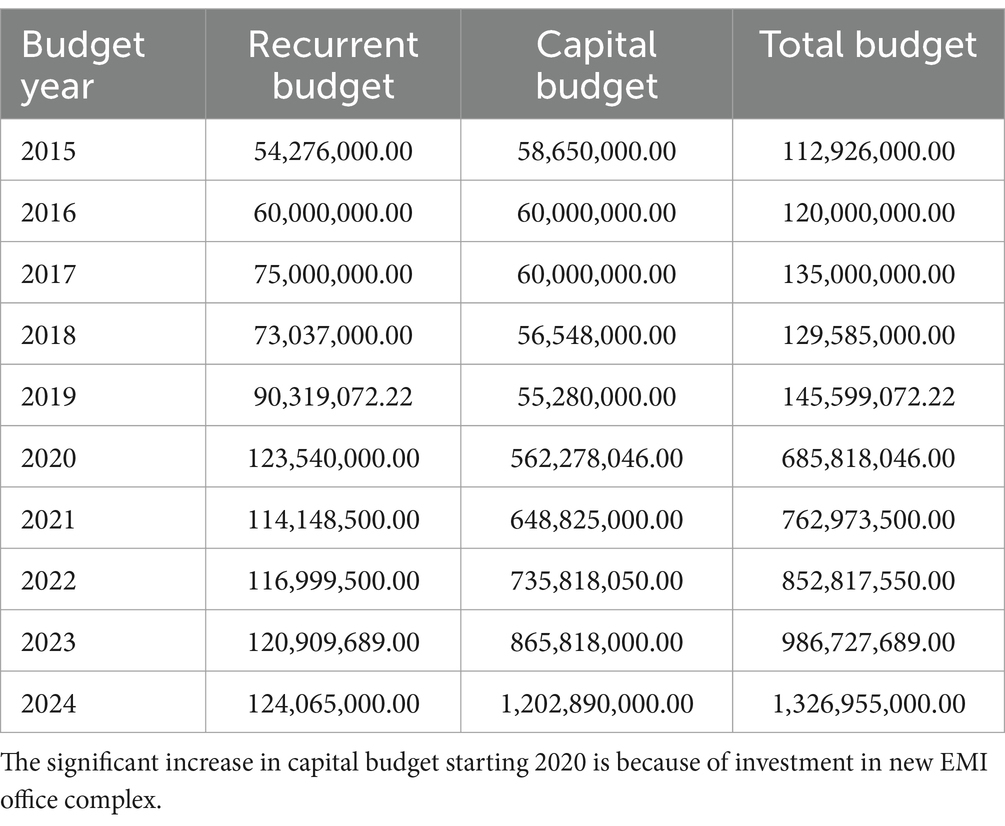
Table 1. The Ethiopian Meteorological Institute (EMI) annual budget (in Ethiopian Birr) as allocated by the government for the past 10 consecutive years.
Additionally, EMI’s early adoption of seasonal climate prediction in 1987 and the Enhancing National Climate Services (ENACTS) approach (Dinku et al., 2022; Dinku et al., 2018) in 2012, set a precedent in Africa. The early adoption of seasonal forecasts, nearly a decade ahead of many other NMHS and regional climate prediction centers (for instance, Drought Monitoring Center based in Nairobi, which was the predecessor of IGAD climate prediction and Application center (ICPAC), issued the first Climate Outlook in 1998; ICPAC, 2023) in the region, highlights EMI’s forward-thinking approach to climate prediction and its recognition of the value of seasonal forecasts for critical sectors, such as agriculture and water resources management.
Implementation of the Enhancing National Climate Services (ENACTS) initiative represents a transformative approach to climate data accessibility and usability in Ethiopia. By developing high-resolution, spatially and temporally complete climate datasets, EMI has enabled access to reliable, high-quality climate information at local scales, which is essential for effective decision-making in various sectors. ENACTS empowers diverse users with tailored climate products, including visualizations through online Map rooms (Nsengiyumva et al., 2021).
EMI’s over 70 years of continuous service provide valuable lessons that can be shared with other NMHSs in Africa and beyond. Through an analysis of EMI’s structure, functions, and growth trajectory, the paper offers readers a broader understanding of how NMHSs operate and the challenges they face across the African continent. It not only delves into EMI’s unique achievements but also provides a comparative perspective on the structure, challenges, and importance of NMHSs across Africa. It underscores the essential functions these institutions serve in climate-sensitive sectors, making it a valuable resource for understanding the broader role of meteorological services across the continent.
The insights shared here come from the experiences and first-hand knowledge of current employee (first authors) and two former employees (second and third authors) of EMI. It also includes some lessons learnt from recent surveys that targeted 184 government officials, 300 sectoral experts, and 159 EMI staff from across the country.
This paper seeks to explore and address the following three key questions:
i. What progress has EMI made over the past seven decades in the generation, dissemination, and application of weather and climate information in Ethiopia? This includes an examination of how EMI has evolved in terms of technical capacity, infrastructure, and institutional partnerships, as well as the extent to which its services have supported climate-sensitive sectors such as agriculture, water resources, health, disaster risk management, and energy.
ii. What have been the major challenges faced by EMI throughout its history? This involves analyzing both historical and contemporary challenges, including issues related to funding, institutional capacity, technological limitations, engagement with end-users, and the integration of climate information into national and local decision-making processes.
iii. What does the future hold for EMI, and what opportunities exist for strengthening weather and climate information in Ethiopia? This includes an exploration of emerging opportunities for EMI to expand and enhance its services.
The paper begins with an overview of the history of weather and climate services in Ethiopia and the services provided (Sections 2 and 3). It then discusses the progress made and challenges faced (Sections 4 and 5), and concludes with a look at future opportunities (Section 6). The final section (Section 7) summarizes the findings and provides recommendations for enhancing climate services.
The collection of meteorological data in Ethiopia began in 1890 with the establishment of two observation stations (Adamitullu and Gambella). At the turn of the 20th century, additional meteorological stations were set up across central, northern, and southwestern Ethiopia. Preliminary meteorological activities were conducted between 1946 and 1949, primarily for the purpose of desert locust monitoring. The expansion of meteorological stations accelerated in the mid-1950s (Figure 1) as the significance of weather information for the aviation sector became evident. This recognition led to the creation of Ethiopian Meteorological Services as a small unit under the Ethiopian Civil Aviation Authority in 1951, which grew to the status of a department by 1971. Over time, the department broadened its focus to provide services to other critical sectors, including water resources and agriculture. This progression ultimately resulted in the formation of the National Meteorological Services Agency (NMSA) under the then Water Resources Commission of Ethiopia in 1980.
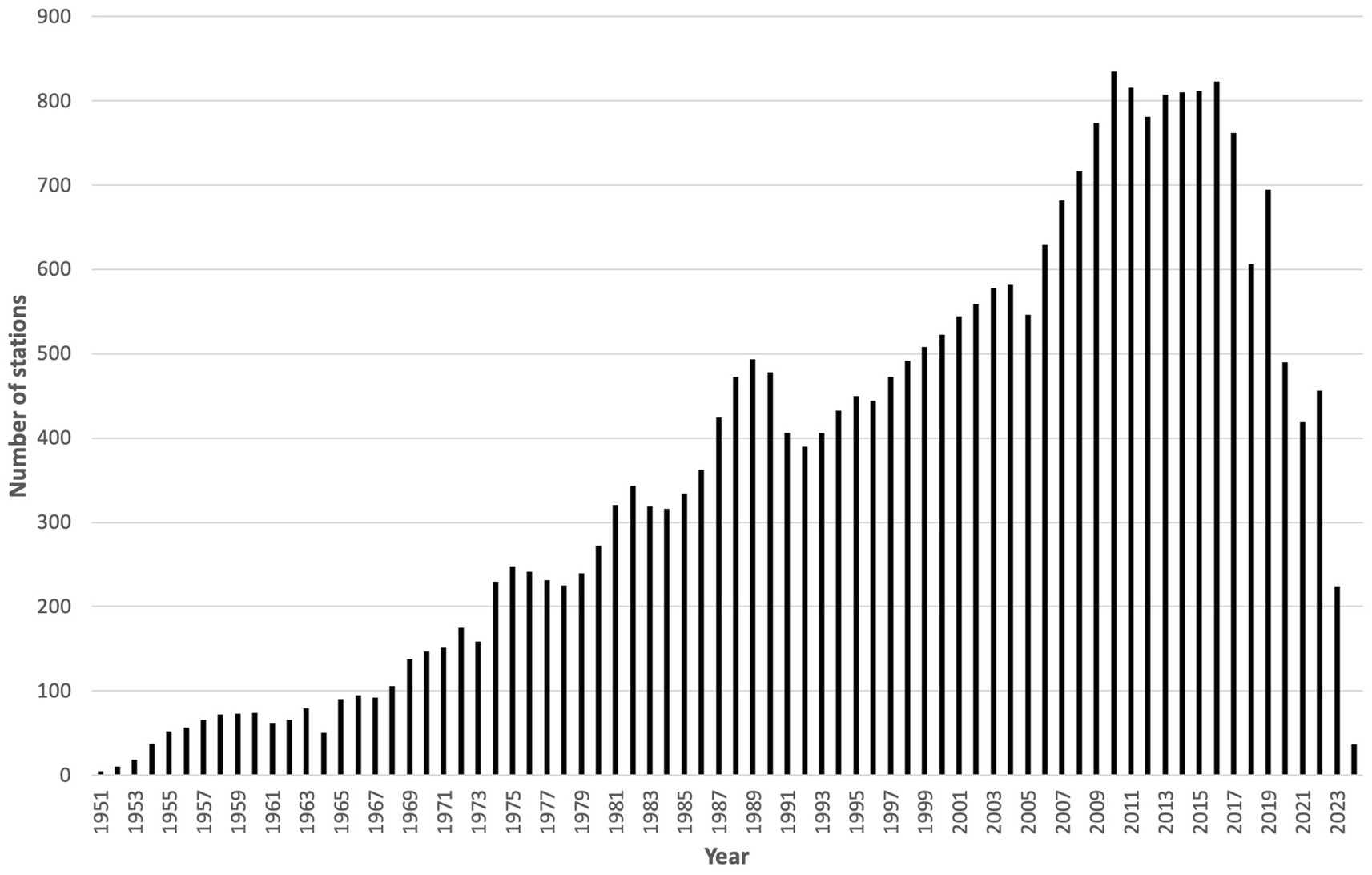
Figure 1. Number of conventional meteorological stations reporting data for each year between 1951 and 2024 in Ethiopia.
The 1980 proclamation formally established NMSA as the principal agency responsible for all meteorological observations and forecasting in Ethiopia. The primary mandate of NMSA included the provision of meteorological and climate services, conducting meteorological research and studies, offering training and advisory services, and fulfilling Ethiopia’s international obligations related to meteorology.
At its inception in 1980, NMSA was structured into five operational departments, each responsible for specific functions:
i. Basic Meteorological Services: responsible for meteorological instruments, radio communication, calibration, and maintenance of meteorological equipment;
ii. Data and Computer Department: tasked with centralized data archiving, quality control, data management, and computational services;
iii. Research and Studies: focused on meteorological training, research, satellite observations, climate change studies, and maintaining a meteorological library;
iv. Meteorological Forecast: in charge of short, medium, and long-range weather forecasting, public weather services, and early warning systems;
v. Operational Meteorology: provides specialized services in agro meteorology, hydrometeorology, and aviation meteorology.
To facilitate regional coordination and service delivery, sub-national (zonal) meteorological offices were also established in various parts of the country, including Central (Addis Ababa), Northeast (Kombolcha), Northwestern (Bahirdar), Western (Jimma), and Southern (Hawassa) parts of the country. These offices were responsible for the establishment of stations, data collection, station inspection, instrument calibration and maintenance.
In 2006, following the then national election and government restructure government’s decision and some institutional restructuring, NMSA changed its name to National Meteorological Agency (NMA) without any changes to its roles and responsibilities. Then in 2021, as part of broader government reforms, the National Meteorological Agency was restructured and renamed as the Ethiopian Meteorological Institute (EMI). This latest restructuring is aimed at enhancing the range and quality of meteorological services provided, with a renewed focus on education, training, and research related to meteorology. This evolution reflects the country’s commitment to strengthening its meteorological capabilities to meet the increasing demand for accurate and timely weather and climate information and support sustainable development and disaster risk management.
The Ethiopian Meteorological Institute (EMI) is mandated to establish and operate a national observation network of meteorological stations. It is responsible for archiving and disseminating meteorological data, as well as exchanging meteorological data in accordance with international agreements to which Ethiopia is a party. While other institutions may collect meteorological data for their own use, they are required to obtain EMI’s approval for such activities. Currently, EMI administers both manual and Automatic Weather Stations (AWS) throughout the country. The network includes various types of meteorological stations: synoptic and first-class stations that measure 13 meteorological parameters. Synoptic stations are used for international data exchange in accordance with World Meteorological Organization (WMO) standards. The data collected from these stations support routine weather monitoring and public weather briefings. Observations are typically conducted at 3-h intervals over a 24-h period, as recommended. However, National Meteorological and Hydrological Services (NMHS) are not obligated to share data collected from first-class stations. Third-class stations measure temperature and rainfall, and fourth-class stations that measure only rainfall (Figure 2).
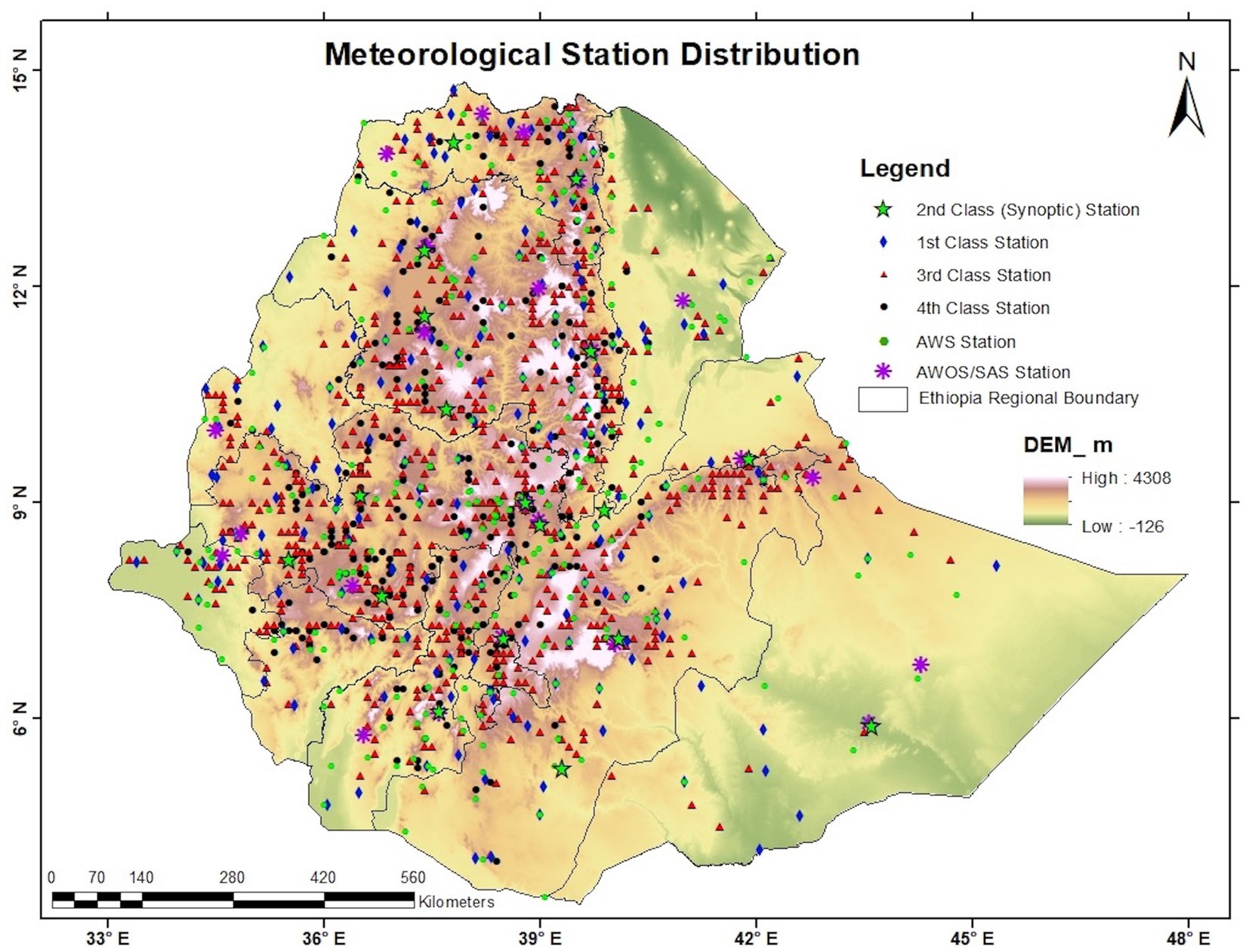
Figure 2. Distribution of conventional and automatic meteorological stations in Ethiopia. The background shows elevation in meters.
Additionally, EMI operates a range of observation platforms, such as Automatic Weather Stations (AWS), which are installed at various geographical locations. In contrast Automatic Weather Observing Systems (AWOS) are installed in air ports for aviation services only, weather radar, upper-air observation stations, air pollution monitoring stations, and lightning detection systems. Automatic Weather Stations collect and transmit meteorological data every 15 min from locations across the country. AWOS are primarily used for aviation services, enhancing safety in air transport. Weather radars play a crucial role in monitoring severe weather conditions, particularly around airports, and are used for rainfall estimation and flash flood forecasting. Upper-air observation stations gather data on various weather elements from the ground up to approximately 30 km into the atmosphere. Air pollution monitoring stations track different pollutants, while lightning detection systems, part of EMI’s remote sensing capabilities, are used to detect and monitor lightning activity.
EMI is tasked with providing meteorological forecasts, early warnings, and advisory services to address adverse weather conditions, flash floods, droughts, air pollution, and climate change. The forecasts produced by EMI are issued at varying lead times that include short-term forecasts (up to 3 days), medium-range forecasts (3–10 days), and long-range forecasts (10 days to seasonal outlooks). These forecasts are disseminated to the public through electronic and print media, the National Climate Outlook Forums (NCOF), and platforms such as the National Disaster Risk Management Council and the Basin Management Council, as well as through other government channels.
Applied meteorology focuses on delivering weather and climate services tailored to key economic sectors in Ethiopia. These include agrometeorology for the agricultural sector, hydrometeorology for the water and energy sectors, biometeorology for the health sector, and civil aviation meteorology for air transport navigation. For the agricultural sector, EMI provides advisory services designed to enhance productivity. These weather and climate information and advisories are very useful for the critical periods such as sowing, weeding, pesticide application, and harvesting. Hydrometeorological services support water resource management and energy generation, drawing on historical data as well as short, medium, and long-term forecasts. These services are especially vital for organizations such as the Ministry of Water and Energy, Ethiopian Electric Corporation (EEC), Ethiopian Electric Power (EEP), and dam monitoring and flood management authorities. For the health sector, EMI offers advisories to help monitor vector-borne diseases like malaria and water-borne illnesses. The civil aviation meteorology services provided by EMI ensure the safety of flights during takeoff, enroute, and landing.
EMI conducts research aimed at enhancing operational meteorological services, advancing weather and climate science, and supporting climate change adaptation and mitigation. As a research institute, EMI has increased its focus on producing high-quality research outputs. In collaboration with the Ethiopian Meteorological Society (EtMS), EMI has established a joint research journal to share findings with the scientific community. The current career structure at EMI encourages its staff to publish in international journals, which supports their promotion from one professional level to the next.
EMI also provides both short-term and long-term training programs to build capacity among its staff. Training areas include meteorological observations, instrument installation, calibration, and maintenance, and weather forecasting. For over 40 years, EMI has conducted one-year training programs for meteorological observer technicians and meteorological forecasters. Capacity-building training extends to meteorological forecasting and applied meteorology.
Weather and climate data are fundamental to climate risk management across all climate-sensitive sectors, making these services a core aspect of EMI’s mission. The weather and climate data collected by EMI underpin a range of services, from raw climate data for research and academic purposes to detailed advisories for farmers, decision-makers, and government officials. EMI’s forecasts play a crucial role in formulating advisories that assist decision-makers and communities at the grassroots level. Dissemination of climate information products occurs through various channels, including the media, its webpage, governmental bodies (such as the Ethiopian Disaster Risk Management Commission, Basin Management Council, Ministry of Agriculture, and Ministry of Health), and participants of the National Climate Outlook Forum (NCOF).
To enhance service delivery and reach a broader audience, EMI’s current organizational structure is divided into two main wings led by Deputy Director Generals. The Basic Meteorological Observation wing manages meteorological instruments and infrastructure, data and climatology, research, education and training, and oversees the coordination of 11 Regional Meteorological Services Centers were located in Ethiopia which are Tigray, Afar. Weast Amahara, East Amhara East Oromia, Central Oromia, Western Oromia, southern Oromia, Benushangul Gumuz, Gambella, Somali, and Sidama. Decentralization is essential to ensure that weather and climate services are accessible to as many of Ethiopia’s over 120 million citizens as possible. To support this goal, EMI has established 11 RMSCs that deliver meteorological advisory services at the local level. These regional centers are structured similar to EMI’s headquarters but with more emphasis on data collection and local-level weather and climate services provision. The Meteorological Forecast and Advisory Services wing is responsible for forecasting and early warning, integrated sector-specific services such as agrometeorology, hydrometeorology, biometeorology, aviation services, and climate change management.
Over the past seven decades, weather and climate services in Ethiopia have shown remarkable progress. The EMI has witnessed significant growth in its meteorological observation network, with an increased number of both conventional and automated weather stations. Advances have also been made in the areas of meteorological forecasting, early warning and advisory services, human resource development, infrastructure enhancement, international cooperation, the creation of a more conducive working environment, and the decentralization of service provision through the establishment of Regional Meteorological Services Centers (RMSCs). The following sections provide a detailed overview of these advancements.
One of the most notable achievements in Ethiopia’s weather and climate services has been the development and expansion of its meteorological infrastructure. The Ethiopian government has demonstrated strong commitment by allocating resources for the improvement of meteorological services. Additionally, EMI has received substantial support from regional and international development partners, which has bolstered efforts to expand its observation network. Most of the historical meteorological and agro-climate databases at have been fully digitized, though a significant portion still requires data rescue. All archived EMI data up to 2020 have been photographed and scanned.
Currently, EMI manages 209 synoptic and first-class stations, 826 third-class stations, and 337 fourth-class stations, totaling 1,372 manual meteorological stations (Figure 2). The modernization of the observation network has also been prioritized, with rapid increase of Automatic Weather Stations (AWS) over the last 10 years (Figure 3). To support aviation, Automatic Weather Observing Systems (AWOS) have been installed at 18 domestic and four international airports. EMI also operates two upper air observation stations, three air pollution monitoring stations, and 13 satellite receiving ground stations at EMI’s HQ and RMSCs.
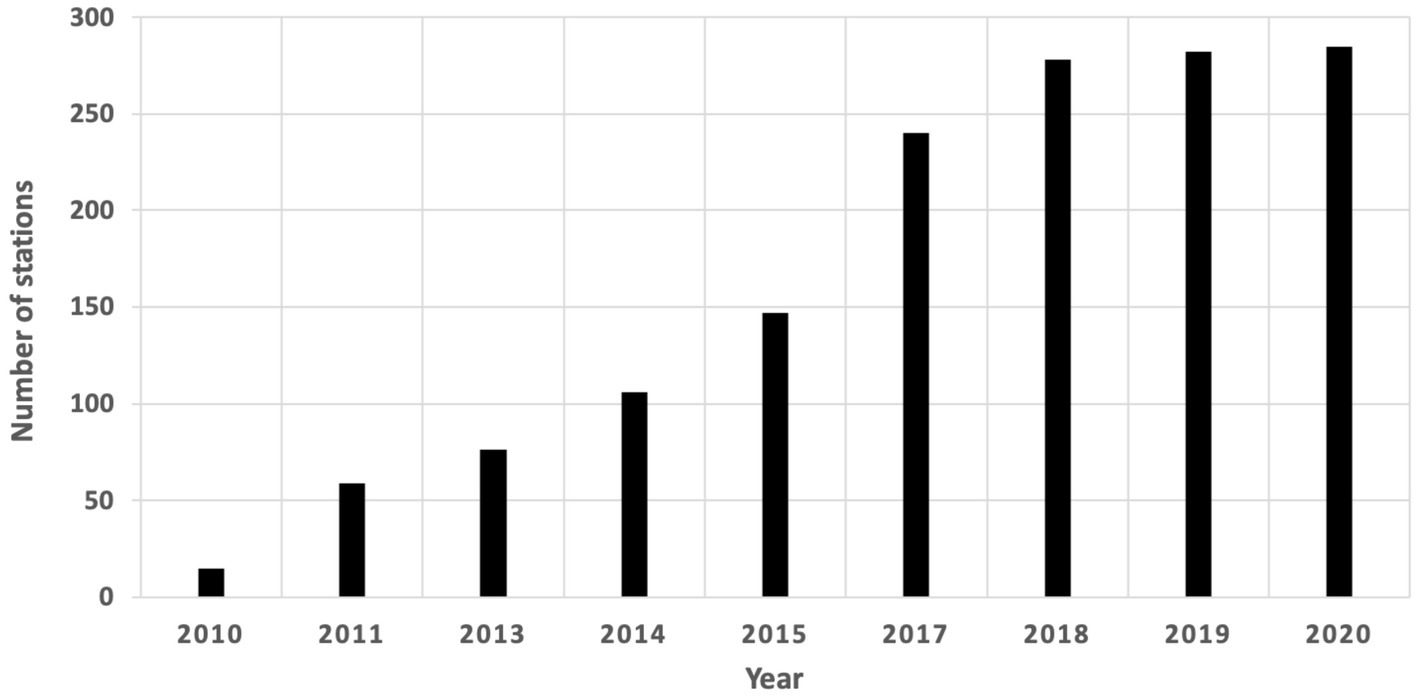
Figure 3. Number of Automatic Weather Stations for each year from 2010 to 2020 in Ethiopia. These stations are not part of the stations shown in Figure 1, and represent efforts to expand and modernize the observing network.
The installation of four weather radars is expected to strengthen EMI’s capability to monitor extreme weather events and short-lived meteorological hazards. The first radar was installed in northern Ethiopia at Shawura (Northwest Amhara Regional State) in 2012. The second C-band Dual Polarization Doppler weather radar is currently being installed at Enewari (North Shoa, Amhara). The remaining two radars, proposed for installation at Mako (Oromia) and Demboya (Central Ethiopia), are also undergoing installation. Together, these radars provide coverage for most parts of the country that receive over 750 mm of annual rainfall (Figure 4). This shows significant government and partner support in enhancing the meteorological observation network in Ethiopia.
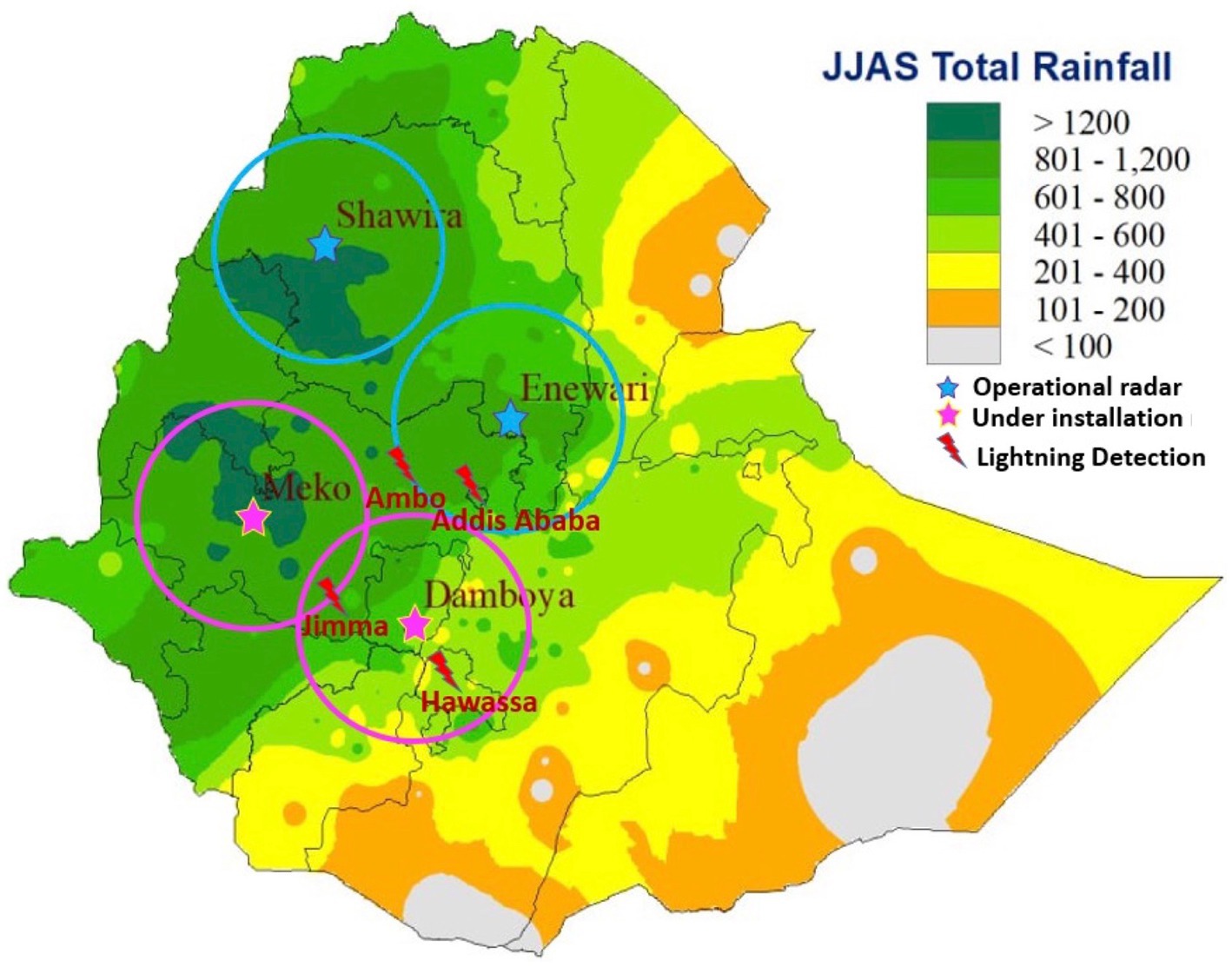
Figure 4. Composite coverage of the four weather radars and lightening detection instrument cites. Background is long-term rainfall mean in mm for the June–July–August–September (JJAS) season in Ethiopia.
Despite managing over 1,372 manned stations and nearly 300 AWS, there remain regions without sufficient coverage (Figure 2). To address this, EMI has implemented the Enhancing National Climate Services (ENACTS) approach (Dinku et al., 2022; Grossi and Dinku, 2022), which has enabled the generation of temporally and spatially complete rainfall and temperature time series dating back to 1981. This is accomplished by combining quality-controlled data from national observation networks with satellite estimates for rainfall and climate model reanalysis products for temperature (Dinku et al., 2022). The Climate Data Tool (CDT, Dinku et al., 2022) is used to perform these tasks. The result is fostering the availability and accessibility of over 40 years of rainfall and temperature time series at 4 km spatial resolutions (Figure 5). These datasets have substantially enhanced EMI’s capability for climate analyses, monitoring weather patterns, and providing more location-specific weather and climate forecasts.

Figure 5. Sample merged satellite rainfall estimates with station observation (A) and reanalysis product with station temperature observation (B) for Ethiopia.
Weather and climate forecasts are the most widely recognized and utilized climate information products provided by EMI. This is corroborated by the survey results gathered from both users (Table 2) and EMI staff (Table 3). More than 50% of the surveyed users identified weather and climate forecasting as EMI’s primary function, highlighting the significant reliance on and recognition of this service. Additionally, 45% of the users reported that they primarily use weather and climate forecasts issued by EMI, underscoring the central role these products play in meeting their information needs.
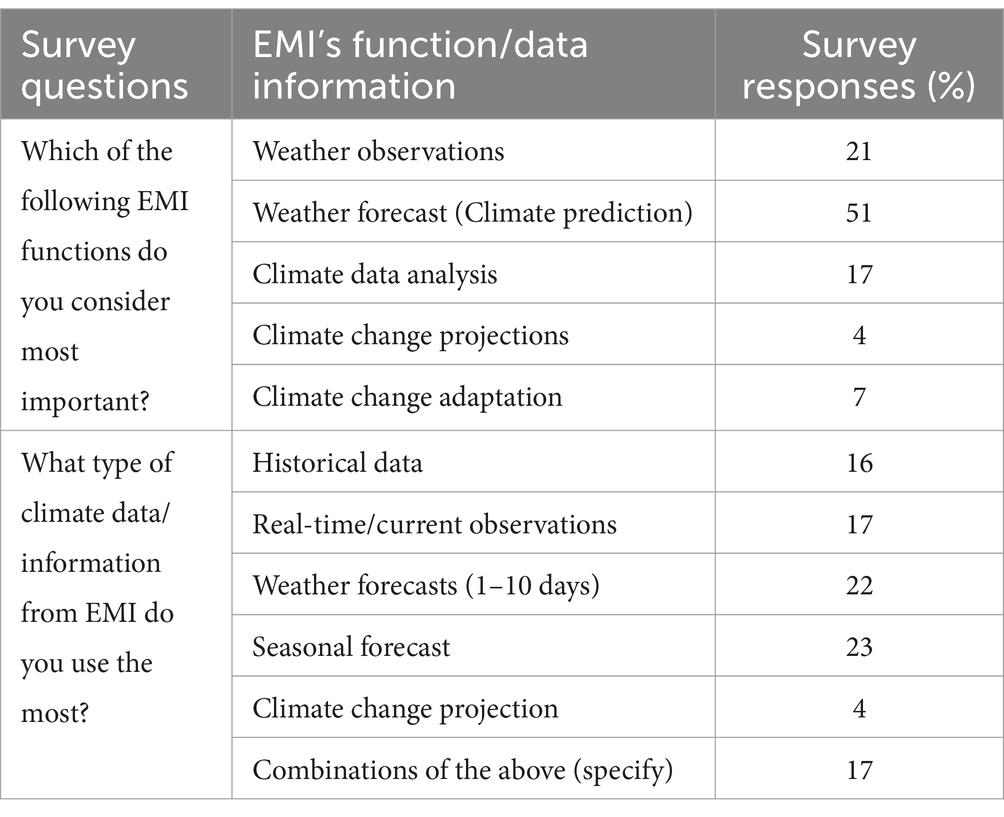
Table 2. User survey responses (%) to two survey questions related EMI functions and what the user considers the most important information from EMI (number of respondents = 484).
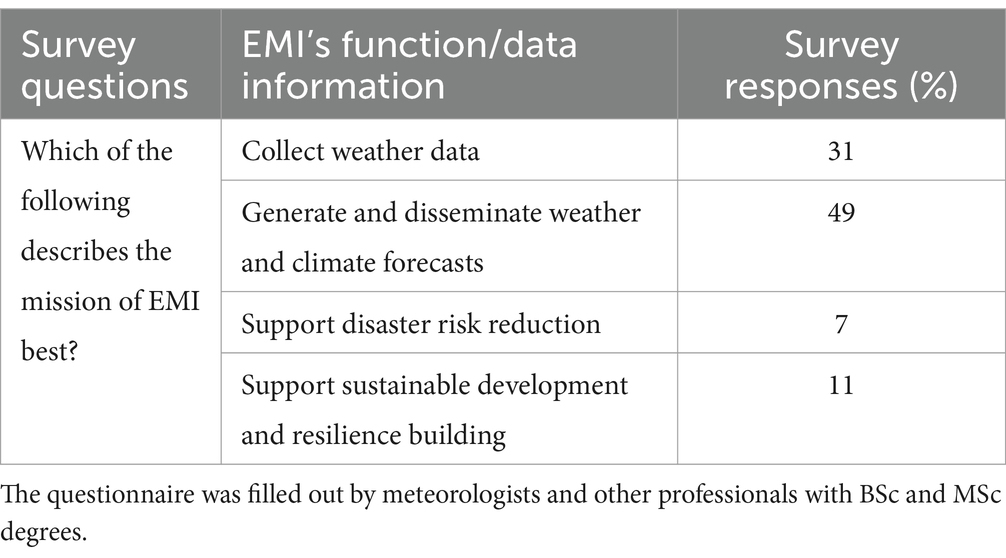
Table 3. EMI staff survey responses (%) related to the mission of EMI (number of respondents = 159).
The perception of EMI’s primary mission is strongly aligned among its staff, with the majority emphasizing that the generation and dissemination of weather and climate forecasts constitute EMI’s core responsibility. This alignment between user expectations and institutional focus reflects the critical importance of weather and climate forecasts in supporting decision-making across various sectors, particularly those reliant on timely and accurate climate information for disaster risk management, agriculture productivity, and resource planning. However, the fact that both users and staff mention forecasting as the main function of EMI could also be a problem as it forecasts are a small part of what EMI actually offers.
EMI has made considerable progress in weather forecasting at various lead times. Its forecasting services include short-range (now casting up to 72 h), medium-range (up to 10 days), and long-range (monthly and seasonal predictions) forecasts. Advancements in forecasting have been facilitated by improved real-time observational data, advancements in meteorological science, and computational technology, and enhanced climate modeling skills at the global level. EMI utilizes outputs from global climate prediction centers as inputs for its models, resulting in more reliable forecasts. This has enabled EMI to use Numerical Weather Prediction (NWP) for forecasts from hours to 10 days (e.g., Figure 6A).
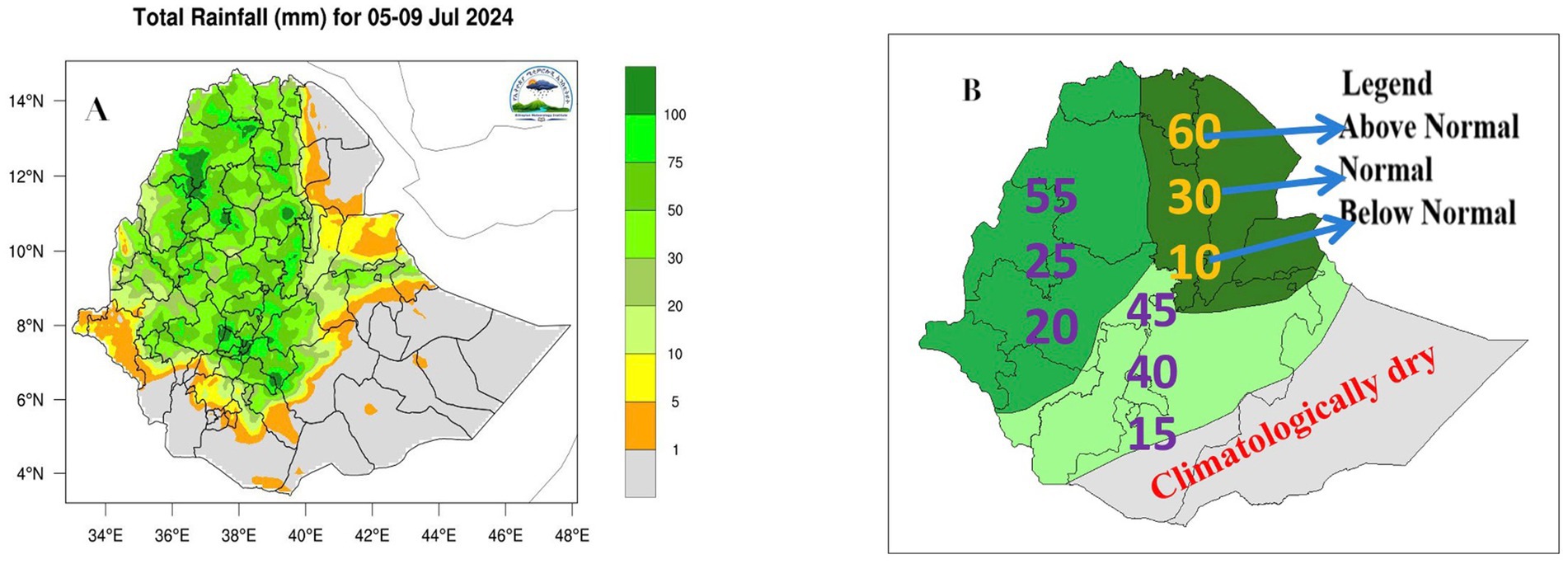
Figure 6. Short-range weather forecast product (A) and seasonal rainfall forecast presented as tercile probabilities (B).
Ethiopia’s milestone in seasonal rainfall prediction was achieved in 1987, when it became the first African country to launch such predictions, and these capabilities have since evolved (Korecha and Sorteberg, 2013). EMI’s seasonal forecasts cover three seasons: June-to-September Kiremt, October-to-January Bega, and February-to-May Belg. Seasonal forecasts are presented in probabilistic formats as shown in Figure 6B.
Enhanced forecasting benefits sectors such as agriculture, water management, and disaster preparedness by enabling stakeholders to make informed decisions. Farmers can optimize planting and harvesting schedules, water managers can better allocate resources, and disaster response agencies can prepare more effectively.
Capacity building has been a priority for EMI, supported by the government and international partners. EMI has conducted training programs, workshops, and conferences to improve the skills of meteorologists and climate scientists. Collaborations with universities and development partners have facilitated the enhancement of EMI’s technical and human resource capabilities.
EMI has signed a Memorandum of Understanding (MoU) with the Ethiopian Water Technology Institute (EWTI) to provide a postgraduate diploma program for first-degree holders in mathematics, physics, chemistry, and statistics. EMI has also partnered with Addis Ababa, Haramaya, Hawassa, Mekelle, and Adama universities to train staff in MSc programs focusing on agrometeorology, disaster risk management, climate change and environment, and climate modeling. Arba Minch University, which has been a longstanding partner in human resource development, has recently launched PhD programs in meteorology, and climate change and sustainable development programs recently.
EMI staff have also benefited from international fellowships and scholarship programs provided by United Nation Development Program (UNDP), the British Council, the Swedish government, the Korean International Cooperation Agency (KOICA), and WMO among many others. In the 1980s and 1990s, these programs supported advanced diploma training in meteorology, and more recently graduate programs in meteorological sciences at institutions like the UK Met Office, Reading University, India Meteorological Department (Pune), Institute of Meteorological Training and Research (Nairobi), Nairobi University, Nanjing University of Science and Technology in China and Wuhan Women University of south Korea. This has substantially increased the number of postgraduate degree holders at EMI. Between 2012 and 2024, the number of staff with MSc degrees has increased from just eight to 121, and eight staff members are currently pursuing PhD degrees.
Another significant capacity development initiative is the construction of a state-of-the-art complex, comprising 3 nine-story buildings, fully funded by the Ethiopian government. This ambitious project represents a major investment in the modernization and expansion of EMI’s infrastructure. Once completed, the facility is expected to serve as a cutting-edge hub for advancing weather and climate services in Ethiopia. The construction is anticipated to be finalized by mid-2025. These new buildings are designed to accommodate modern technologies, enhanced data processing capabilities, and improved facilities for research, forecasting, and dissemination of climate information. The complex will also provide a conducive environment for training and capacity building of EMI staff, fostering collaboration with local and international partners, and ensuring the institute is well-equipped to meet the growing demand for accurate, timely, and actionable climate services.
The advancements in EMI’s observation and forecasting capabilities have enabled it to provide enhanced services across the range of sectors, including agriculture, water management, health, and disaster risk management. In the field of agrometeorology, EMI delivers critical advisories on soil moisture conditions, crop water requirements, and the timing of agricultural activities, helping farmers optimize their practices and reduce risks associated with weather variability. Through hydrometeorology, EMI supports water resource management and energy production by supplying reliable rainfall data and forecast which enable sectors to monitor dam levels, river flows, and flood forecasts. These forecasts play a pivotal role in ensuring efficient water allocation, flood mitigation, and the sustainable operation of hydropower plants. In the area of biometeorology, EMI provides health-related forecasts and climate-driven risk assessments, such as monitoring and early warnings for malaria outbreaks and other climate-sensitive diseases. Furthermore, EMI’s contributions to disaster risk management have been critical. The institute supplies early warnings and impact-based forecasts that enable decision-makers to prepare for and respond to climate-related hazards, including droughts, floods, and extreme weather events. These advancements align with Ethiopia’s broader Disaster Risk Management (DRM) roadmap and efforts to enhance climate resilience.
The EMI official website1 serves as a comprehensive resource for a wide range of users, providing valuable insights into the institute’s operations and its weather and climate services. The site features detailed information about EMI, including its history, mission, strategic goals, policies, and publicly available reports, offering transparency and fostering engagement with stakeholders. A notable highlight of the website is its extensive catalog of climate data and information products, designed to cater to diverse user needs. Many of these products, including bulletins and sub-seasonal and seasonal forecasts, are downloadable in PDF format. This feature ensures accessibility for users who may lack consistent internet access, such as farmers and rural communities. These documents can be easily shared offline, allowing information to reach a broader audience and facilitate decision-making at the grassroots level.
Additionally, the website is a critical platform for disseminating early warnings and impact-based forecasts that align with Ethiopia’s disaster risk management priorities. By providing timely and reliable information, EMI’s online presence supports the institute’s mission to enhance climate resilience and socio-economic development in Ethiopia.
A significant advance in climate services in Ethiopia has been the implementations of the Enhancing National Climate Services (ENACTS) approach in collaboration with the International Research Institute for Climate and Society (IRI), Columbia University. The ENACTS approaches strives to improve availability of climate data, access to usable climate information products, and the use of climate information products (Dinku et al., 2022; Dinku et al., 2018). It includes the development of an interactive climate information portal (Maproom) that has enhanced the accessibility and use of climate data (Nsengiyumva et al., 2021). The Maproom (Figure 7) features sections for analysis of historical data, monitoring the current season, anticipating the next season, as well as application-specific products for agriculture, health, water, and disaster risk management. These Maproom products offer user-friendly interfaces to analyze historical, current, and forecast climate data, supporting sectors such as agriculture, health, and disaster risk management in developing informed strategies. This feature positions EMI as a leader in providing customized, decision-relevant climate information that is critical for risk assessment, resilience building, and long-term planning across Ethiopia.
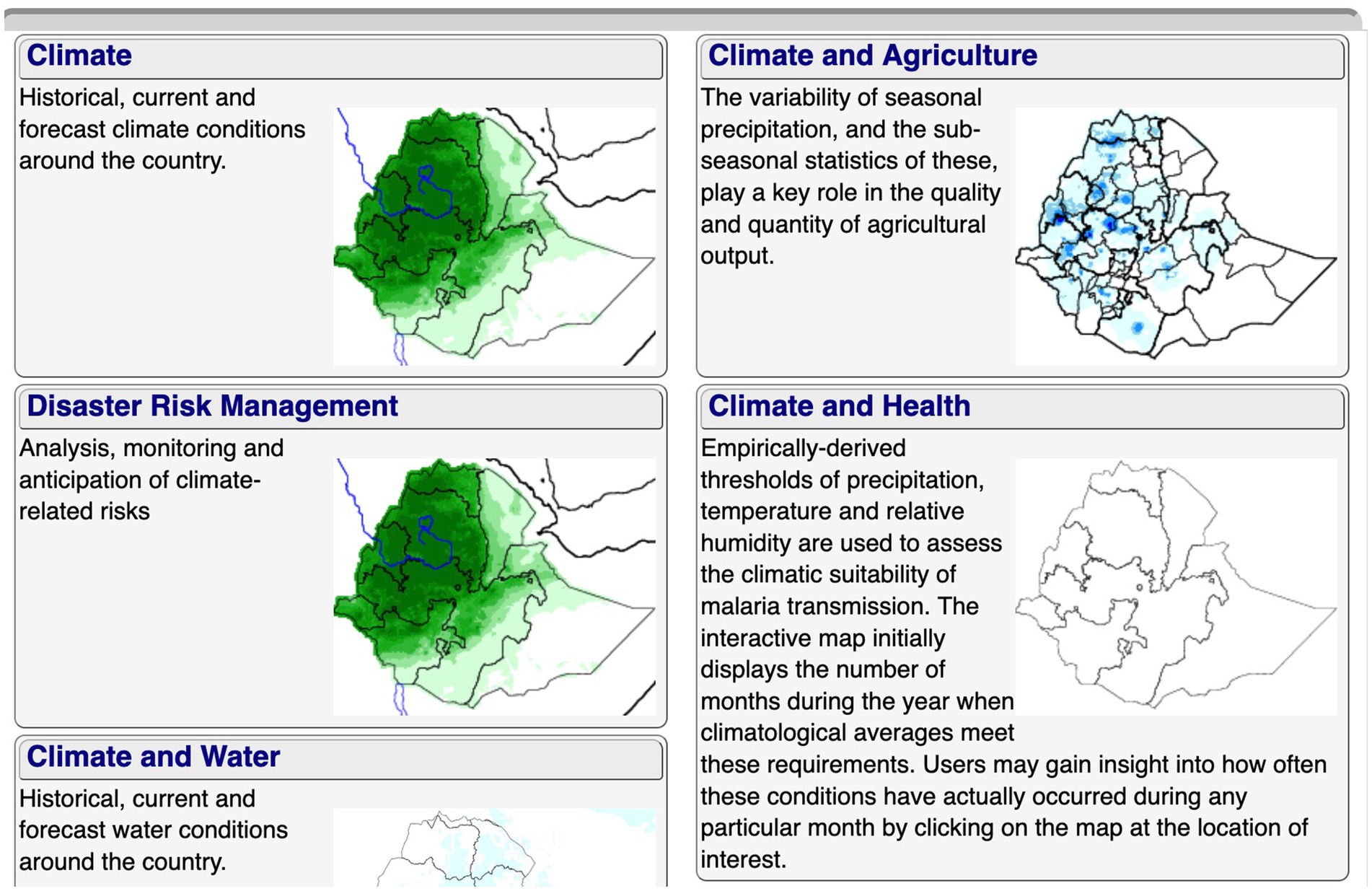
Figure 7. The ENACTS “maprooms” that provides online access to an array of climate information products for different applications in Ethiopia (http://www.Ethiometmaprooms.gov.et:8082/maproom/).
The EMI actively fosters stakeholder engagement through various platforms, including the National Climate Outlook Forums (NCOF). These fora are convened at the end of each season and serve as a critical mechanism for reviewing the previous season’s climate conditions and issuing outlooks for the upcoming season. The assessments and outlooks are comprehensive, addressing not only anticipated climate conditions but also their potential impacts on key climate-sensitive sectors such as agriculture, water resources, health, energy, and disaster risk management. The NCOFs bring together a wide range of participants, including policymakers, sectoral experts, practitioners, and representatives from government agencies, non-governmental organizations, and international development partners. These gatherings facilitate dialogue and collaboration, ensuring that climate information is tailored to meet the specific needs of different sectors. The seasonal assessments and outlooks generated during the forums are also disseminated to the general public through mass media channels, such as radio, television, printing, and social media.
In addition to the national-level fora, EMI organizes Regional Climate Outlook Forums (RCOF) at sub-national levels. These regional platforms are designed to address localized climate issues, making them particularly valuable for addressing the diverse climate risks faced by Ethiopia’s varied ecological zones. By focusing on regional contexts, RCOFs enable more targeted guidance and foster community-level resilience planning.
In order to accommodate the increasing demand for its services, EMI has implemented the National Framework for Climate Services (NFCS) in 2021 with the main climate-sensitive sectors; namely Agriculture, Health, Disaster Management, Environment, Water, and Energy (NMA, 2021a). The national action plan document, signed by the respective ministers and commissioners, was launched in November 2021. This high-level endorsement underscores the government’s commitment to leveraging climate services to support national development goals and build resilience to climate variability and change.
The EMI plays a pivotal role in stakeholder collaboration by serving as a key member of various task forces established as platforms for engagement and coordination among EMI and relevant sectors. These task forces are designed to address the diverse needs of climate-sensitive sectors and ensure that weather and climate services are effectively integrated into sectoral activities and decision-making processes. Notable task forces include Agromet, Hydromet, Health and Disaster Risk Management.
The Agromet Task Force focuses on supporting agricultural activities and the livelihoods of pastoral communities, which are highly vulnerable to climate variability. It brings together stakeholders from the agricultural sector, including government agencies, research institutions, and development partners, to co-develop and disseminate climate services.
The Hydromet Task Force is dedicated to water resource management and disaster risk reduction, particularly during the rainy and dry seasons. During the rainy season, the task force monitors river flows, dam levels, and potential flood risks, providing critical information to mitigate flood-related impacts. In the dry season, it focuses on ensuring adequate water supply for domestic use, irrigation, and energy production. By fostering collaboration between meteorologists, hydrologists, and water resource managers, the task force enhances the country’s capacity to manage its water resources sustainably and respond effectively to water-related challenges.
The Health Task Force is centered on monitoring and mitigating the impacts of climate-related health risks, such as malaria and other vector-borne diseases. By integrating climate data with health surveillance systems, the task force enables health authorities to anticipate outbreaks and allocate resources more effectively.
The Disaster Risk Management Technical Task Force supports decision-makers in climate-vulnerable sectors by providing advisory services and early warning, which enable them to plan for humanitarian support contingency.
Public awareness campaigns and targeted training programs have been instrumental in enhancing the accessibility and effective use of the EMI products and services among diverse user groups. These efforts have focused on empowering end-users, such as agricultural extension officers, disaster response teams, and local planners, with the knowledge and skills necessary to integrate weather and climate information into their decision-making processes.
To reach a broader audience, EMI has conducted public awareness campaigns through mass media, community engagement events, and targeted outreach in rural areas. These campaigns focus on the practical benefits of climate services, such as improved agricultural productivity, reduced disaster risks, and enhanced public health outcomes. By simplifying technical information and delivering it in local languages, these initiatives ensure that even grassroots communities can understand and utilize EMI’s products.
EMI has collaborated with a number of international partners who have contributed to various aspects of its capacity development. Key collaborations include: the International Research Institute for Climate and Society (IRI), Columbia University, to develop comprehensive training curricula on climate risk management, emphasizing the use of EMI’s Maproom products (Dinku et al., 2023). The curricula, which are tailored to the specific needs of different sectors, ensure that users can effectively interpret and apply the climate information provided by EMI. EMI’s partnerships with international organizations, including the World Meteorological Organization (WMO), have further expanded its reach and impact. WMO-funded projects have specifically targeted regions with smallholder farmers, where the need for climate services is most acute. Some other collaborations include the following:
• United Arab Emirates (UAE) through the National Center for Meteorology (NCM) for rain enhancement projects.
• Finland, via the Finnish Meteorological Institute (FMI) and Vaisala, for modernizing observation networks.
• South Korea through the Korea Meteorological Administration (KMA) and Korean International Cooperation Agency (KOICA), focusing on early warning systems.
• Norway through Met Norway for capacity building and as Systematic Observation Facility Financing (SOFF) project peer review.
• Sweden through the Swedish Meteorological and Hydrological Institute (SMHI) for collaboration on Water and climate change services for Africa-Ethiopia (WACCA-E) project.
• China through China Meteorological Administration (CMA) and
• United Kingdom through the UK Met Office for capacity-building initiatives.
Development projects funded by partners such as UNDP, African Development Bank, WMO, International Research Institute (IRI), National Oceanic and Atmospheric Administration (NOAA), and University of California Santa Barbara have laid the groundwork for future initiatives, enhancing EMI’s ability to deliver comprehensive weather and climate services. These resources and partnerships have enabled EMI to expand its observational network, improve forecasting capabilities, and deliver weather and climate advisory services essential for socio-economic development.
While EMI has made substantial progress, it has also faced a complex array of challenges. The main challenges include financial constraints, infrastructure limitations, technical and human resource shortages, computational capability, data accessibility, and dissemination issues, among others. Each of these factors presents unique scientific and operational hurdles for effective weather and climate services in Ethiopia.
A significant challenge for weather and climate services in Ethiopia, as in many developing countries, is limited financial resources. Although the Ethiopian government has shown commitment and provided support, national resources are constrained due to Ethiopia’s status as one of the least developed countries in Africa. Establishing and maintaining meteorological infrastructure and acquiring advanced forecasting tools are expensive endeavors as most of these resources must be imported, requiring hard currency that is difficult to secure. Thus, insufficient funding impacts EMI’s ability to expand its network of weather stations, upgrade forecasting technology, and improve the quality of weather and climate information services. While EMI has received support from international donors and development partners, reliance on external funding poses sustainability issues. Variations in donor funding can disrupt critical projects and programs, adversely affecting the continuity and effectiveness of meteorological services. Besides, many external assistances prioritize the interest of the donor rather than the real challenges of the NMHS.
Technical and human resource limitations present significant challenges to EMI. The scarcity of modern meteorological tools and technologies restricts EMI’s ability to deliver high-quality services. Limited capacity for data storage, processing, and dissemination further complicates EMI’s ability to provide comprehensive and reliable services. The acquisition and maintenance of equipment such as AWS, AWOS, and weather radars, satellite receiving stations, high-performance computing systems, and high-speed internet require substantial financial investments and technical expertise that are difficult to sustain in a resource-limited environment.
One of the pressing challenges is the inadequacy of institutional infrastructure needed for collecting, processing, and disseminating climate data and information. Despite the progress made, Ethiopia’s existing meteorological infrastructure falls short of meeting national needs. EMI’s network of meteorological stations is the primary source of climate data in the country, but station density remains low, particularly in remote and rural areas, creating significant data coverage gaps. Figure 2 illustrates the uneven distribution of stations, which are mainly concentrated along major roads and urban areas. EMI’s 10-year station network master plan, which aims to overcome this challenge, outlines the requirements for the expansion of various types of observation stations, including 1992 conventional stations and 458 Automatic Weather Stations.
Even where stations exist, there are gaps in observation owing to various challenges. Some of the challenges include disruptions caused by security issues, instrument breakdowns due to aging infrastructure and lack of spare parts, communication breakdowns, and vandalism as well as lack of local government commitment to secure observational sites in accordance with the WMO meteorological station network site standard. The combined effect of these challenges is depicted in Figure 8, which illustrates the percentage of data reported by each station relative to the expected data. The figure highlights that remote and lowland region of the country, often sparsely populated, are the most affected by these disruptions.
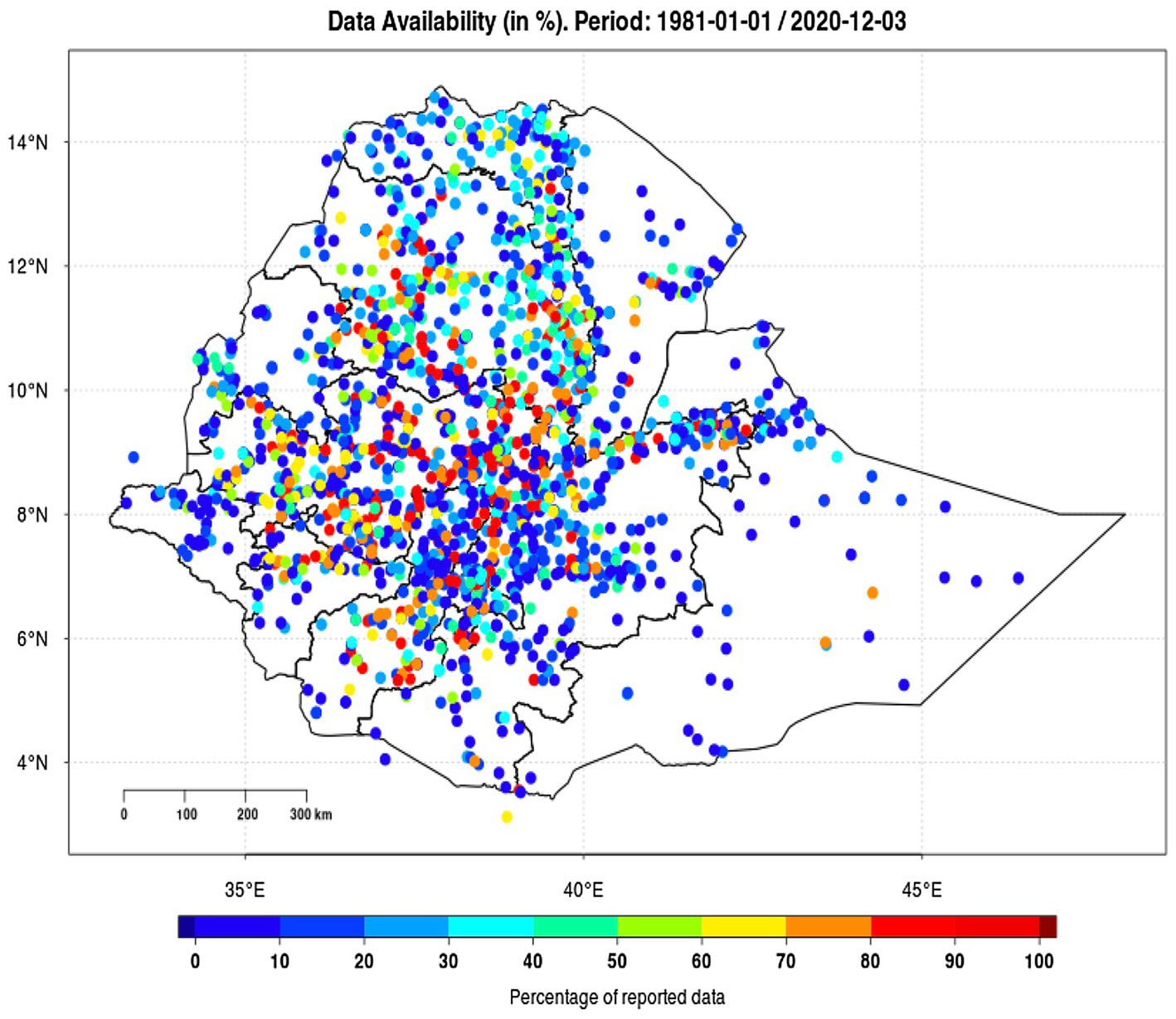
Figure 8. Percentage of data reported by each station between 1981 and 2020 relative to what was expected in Ethiopia.
Security issues, particularly during periods of social unrest, can lead to prolonged interruptions in data collection. For instance, there was a significant disruption in meteorological observations in parts of the country beginning in 1991. This period coincided with intense conflict as rebel forces fought for control of the northern half of the country, ultimately leading to a change in government in May 1991. Such conflicts not only endangered the safety of personnel but also hindered access to monitoring sites, further exacerbating the challenges. Figure 1 provides additional context, showing that it took several years for the meteorological observation network to recover fully from the 1991 disruption. The gradual recovery reflects the complexity of re-establishing operational capabilities after such events, particularly in remote areas where logistical and security challenges are pronounced. A more recent example is shown in Figure 9, which compares number of stations that reported data in 2019 and 2020. There have been armed conflicts going on in the northern half the country which has led to the significant decline in the number of stations sending data to EMI Head Quarters. The two panels in Figure 9 compare how many dekades (10-day period) of data were sent (number of data points (dekades) for each station should be 36). There is a clear decline in the number of data sent to HQ from 2019 to 2020 over the northern half of the country flowing an outbreak of a civil war.
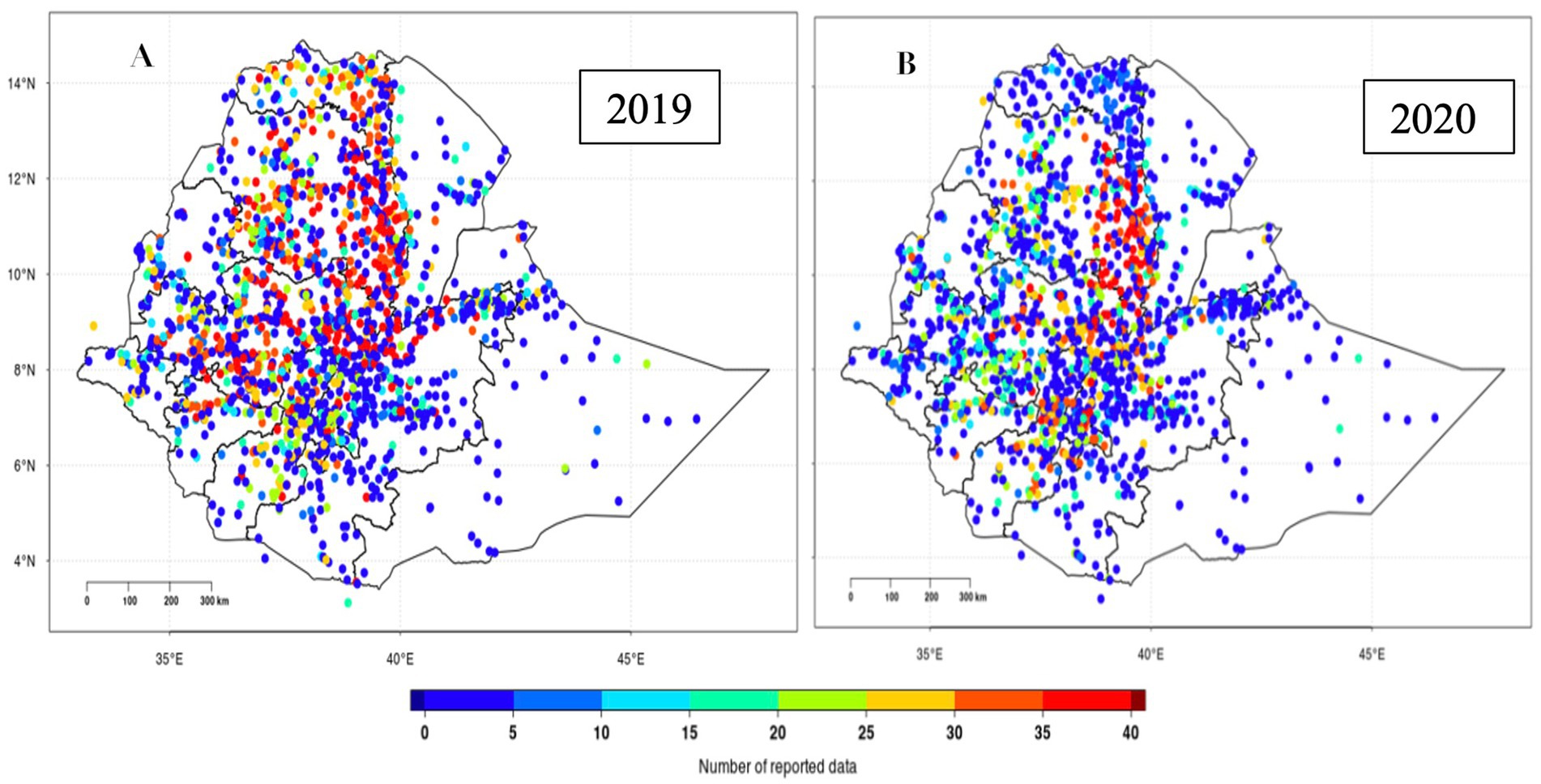
Figure 9. Amount of data in dekads (10 days) reported by each station during 2019 (A) and 2020 (B) in Ethiopia. The number of data points (dekades) for each station should be 36. The decline in the number of data sent to HQ from 2019 to 2020 over the northern half of the country is attributed to an outbreak of a civil war over that part of Ethiopia.
These challenges underscore the importance of investing in robust infrastructure, ensuring a steady supply of spare parts, enhancing communication networks, and implementing measures to protect meteorological stations from vandalism and damage during periods of instability.
EMI has worked to expand its observation network with additional AWS installations. However, maintaining, operating, and effectively utilizing these AWS is challenging due to limited resources and high maintenance costs, including the procurement of replacement parts. These challenges are compounded by the varied data formats and systems used by different AWS networks, provided by various donors, making data integration and usage complex (Faniriantsoa and Dinku, 2022).
Another critical issue faced by EMI is the persistent shortage of skilled meteorologists and technical experts, exacerbated by high staff turnover. This challenge is largely driven by uncompetitive salary scales and a lack of attractive benefits in the government sector, which push experienced professionals to seek better opportunities in other organizations. This trend has significantly impacted EMI’s ability to retain institutional knowledge and maintain a high standard of service delivery. The findings of a recent survey of EMI staff, presented in Table 4, highlight the seriousness of this issue. Over 20% of employees indicated they are either likely or very likely to leave the institution in the near future. An additional 32% of respondents were neutral, suggesting a considerable portion of the workforce is undecided about their commitment to EMI.
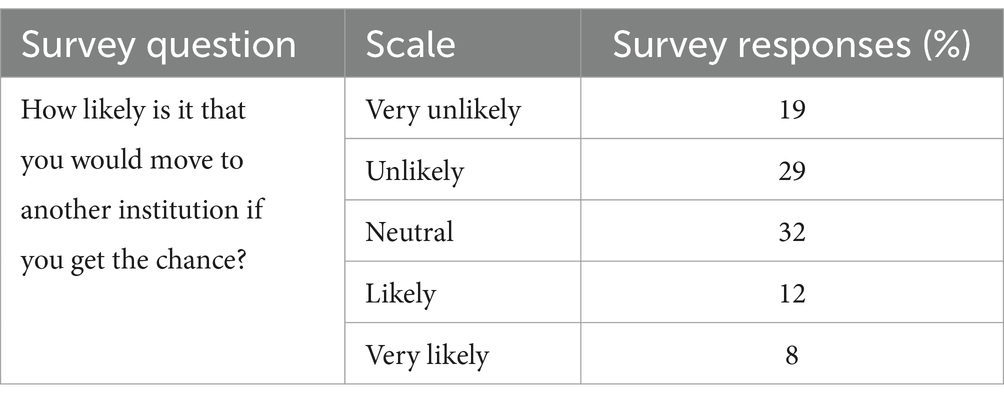
Table 4. EMI staff survey responses (%) on likelihood of moving to another institutions (number of respondents = 159).
The high turnover rate not only disrupts the continuity of operations but also poses a long-term threat to EMI’s capacity to meet its mandate. The frequent loss of skilled personnel means that significant resources must be allocated to recruit and train new employees, further straining the institution’s limited budget. This cycle hampers EMI’s ability to build and sustain a pool of experienced experts essential for advancing meteorological services and disaster risk management efforts in Ethiopia.
Ensuring the accessibility and usability of weather and climate information remains a significant challenge in Ethiopia, particularly for rural and remote communities. Many of these areas lack access to modern communication technologies, such as the internet and mobile phones, which are crucial for receiving timely forecasts and early warnings. In addition to technological barriers, disseminating weather information in a format that is both understandable and actionable is often difficult. Language barriers and low literacy rates further complicate efforts to effectively communicate critical climate information to diverse audiences, particularly in Ethiopia’s multilingual and multicultural context. Sectoral users, including policymakers, planners, and technical experts, also face challenges in utilizing climate services effectively. Many have a limited understanding of the value of these services and lack the capacity to interpret and integrate the information into decision-making processes. This gap often leads to underutilization of the available data, hindering the ability to make informed decisions in disaster risk management agriculture, water resources management, and other climate-sensitive sectors.
EMI has faced its own internal challenges that further exacerbate these issues. Data quality problems, including missing values and gaps in temporal or spatial coverage, undermine the reliability of meteorological information. Additionally, outdated data policies limit the accessibility and timely sharing of data with users, slowing the uptake of climate services. Despite the development of ENACTS data and products, which have significant potential to support various applications, their adoption and exploitation by stakeholders remain limited. This underutilization is often attributed to insufficient awareness, inadequate training, and a lack of integration into national frameworks. It also stems from the fact that both EMI staff and users see weather and climate forecasts as the most important information products (Section 4.2). As a result, EMI has not yet given ENACTS the importance it deserves.
Despite the challenges discussed in the previous section, there are also promising opportunities that could enable EMI to enhance its provision of weather and climate services. Addressing the challenges can be facilitated by taking advantage of new developments in meteorological infrastructure, improved computing capabilities, well-trained personnel, enhanced data and climate information products, and an increasingly aware and capable user community that understands the value of these services.
Significant opportunities exist for strengthening meteorological infrastructure in Ethiopia, including upgrading existing facilities and expanding meteorological station coverage, particularly in underserved regions. This expansion will improve data coverage, enhance the accuracy of weather forecasts, and boost the overall quality of services. Following EMI’s station master plan (NMA, 2021b), efforts are underway to install approximately 100 additional AWS in different parts of the country, with a focus on flood-prone areas and river basins to support timely and accurate flood forecasting and management. Moreover, through a World Bank-supported project, EMI plans to install 107 additional AWS in pastoral areas.
Other planned infrastructure enhancements include adding three new upper air observing stations and increasing the number of synoptic stations from 17 to 29 through the UNDP-funded Global Basic Observation Network-Systematic Observation Facility Financing (GBON-SOFF) project, as well as the installation of two more weather radars.
The construction of a new EMI headquarters complex consisting of 3 nine-story buildings, along with new office buildings for RMSCs, will create a more conducive working environment at both the HQ and regional levels. In particular, the new HQ will provide an opportunity to implement ICT infrastructure and a modernized meteorological data center. Investments in high-performance computing (HPC) systems and integrated data centers will improve the quality and reliability of short-, medium-, and long-range forecasts. The adoption of advanced technologies, such as Artificial Intelligence (AI), will further enhance forecasting accuracy and operational efficiency (Conti, 2024; Dewitte et al., 2021).
EMI plans to continue investing in capacity development programs including workshops, and academic courses to cultivate a generation of professionals capable of conducting comprehensive meteorological analyses and supporting climate-sensitive sectors with accurate information and advisories. Partnerships with international institutions and universities, this strategy will provide avenues for knowledge exchange and capacity building.
While there are currently only two PhD holders at EMI, seven staff members are pursuing doctoral studies at national and international universities. Continued investment in training programs and professional development opportunities will enhance EMI’s technical expertise and strengthen its institutional capacity to deliver timely and accurate climate services. Ongoing efforts include advocating for better retention of skilled personnel through competitive salaries, career advancement opportunities, and an improved working environment. Negotiations are in progress with the government to elevate EMI’s professional workforce benefit to a status comparable to other national research institutes. EMI has submitted to the Civil Service Commission a special benefits package for its professional staff, particularly for researchers. The Commission has sent the proposal to the government for approval, and this still under discussion.
EMI has made considerable progress in leveraging available climate datasets, thanks to initiatives like ENACTS. This approach has allowed EMI to generate over 40 years of daily rainfall and temperature time series at a spatial resolution of approximately 4 km by integrating national observations with satellite rainfall estimates and climate model reanalysis products (Dinku et al., 2022; Dinku et al., 2013). EMI has also started generating other climate variables such as relative humidity, wind, pressure, and radiation. These high-resolution gridded datasets underpin research, application development, and the creation of climate services, including digital advisories and decision-support tools tailored to user needs.
EMI also uses ENACTS tools, such as the Climate Data Tool (CDT; Dinku et al., 2022) and the Automatic Weather Station Data Tool ADT, (Faniriantsoa and Dinku, 2022). These tools facilitate data organizing, quality control, analysis and visualization, enabling EMI to generate a wide range of climate information products. The CDT supports EMI in managing large datasets by enabling systematic data integration, interpolation, and analysis, which is particularly valuable in generating high-resolution climate information products. This tool facilitates EMI’s ability to produce daily, monthly, and seasonal climate summaries that can be customized for various end-user needs, including agriculture, health, and disaster risk management sectors. The CDT also enhances EMI’s capacity for spatial analysis, allowing the Institute to deliver climate insights at local scales, which are critical for operational and planning activities across Ethiopia. The CDT has become a tool widely used by RMSC staff due to its ease of use and widespread training, empowering regional centers to produce localized climate information products.
The ADT enhances EMI’s ability to manage and standardize data from multiple AWS networks across Ethiopia, improving both the accuracy and reliability of climate observations. By implementing rigorous quality control and synchronization, EMI can deliver higher-quality real-time data to stakeholders, which is essential for timely decision-making, particularly in the face of rapid-onset climate events. This capability enables EMI to play a critical role in Ethiopia’s early warning systems, significantly enhancing the country’s readiness for climate hazards and increasing public trust in climate data services.
The ENACTS datasets have significantly improved the availability of high-resolution climate data for research and applications. EMI has been issuing seasonal climate forecasts for over three decades and has refined the accuracy and presentation of these forecasts. ENACTS data allows EMI to produce forecasts at the 4 km resolution using more objective methods, making forecasts available through the National Climate Outlook Forums (NCOF), online portals, bulletins, and media platforms. EMI has also launched Regional Climate Outlook Forums to reach more users directly. The introduction of flexible forecast presentations marks a transformation in how seasonal rainfall forecasts are shared. Instead of the standard tercile format (below normal, normal, above normal), the new presentation allows users to select specific thresholds of interest, either as percentiles or rainfall amounts (Hansen et al., 2022).
Developing user-friendly, context-specific products and communication strategies will enhance the understanding and use of weather and climate information. EMI’s interactive online portal (Maproom) provides easy access to a wide range of climate information products for diverse stakeholders, from agricultural extension officers to policymakers. This supports the integration of weather and climate information into sectors such as agriculture, water management, infrastructure, and public health.
Ensuring the effective uptake of these products requires user awareness and capacity development. Users need to be familiar with EMI’s online products and trained in how to navigate, understand, and apply them. Recognizing the importance of agriculture to Ethiopia’s economy and the vulnerability of the sector to climate variability, EMI has participated in the development of a specialized curriculum focused on Climate Risk Management for Agricultural Extension. This curriculum aims to build the capacity of agricultural professionals and extension workers to integrate climate information into their practices (Dinku et al., 2023). By equipping them with knowledge and tools to interpret climate data, EMI enables these professionals to support farmers with actionable insights for adapting to and mitigating climate risks. This curriculum strengthens local-level resilience, helping to minimize crop losses, optimize planting and harvesting schedules, and promote sustainable agricultural practices. EMI’s approach in linking climate services to agricultural extension underscores its commitment to directly addressing sectoral needs, fostering resilience among smallholder farmers, and supporting Ethiopia’s food security goals. There are plans to develop similar curricula the other sectors.
The National Framework for Climate Services (NFCS) offers a robust framework for engaging stakeholders, including communities, extension services, government agencies, civil society organizations, and more. It strengthens collaboration between EMI and relevant sectoral ministries and promotes the establishment of multi-sectoral platforms for sharing weather and climate information. Notable progress in implementing NFCS in Ethiopia over the past 4 years includes a participatory approach involving development partners, key economic sectors, the World Meteorological Organization (WMO), International Research Institute (IRI), Accelerating Impacts of CGIAR Climate Research for Africa (AICCRA), and local NGOs such as Christian Aid. These efforts have culminated in three key documents: a baseline assessment identifying gaps in service delivery, a 10-year strategic plan aligned with national goals, and a coordination guideline outlining the roles of stakeholders at federal, regional, zonal, and woreda (district) levels. These collaborative efforts will enable co-design and co-development of products, fostering ownership, uptake, and the integration of climate services into policy, planning, and practice in Ethiopia.
The Ethiopian Meteorological Institute (EMI) has made substantial progress over the last several decades in advancing the generation, dissemination, and use of weather and climate information in Ethiopia. Key areas of progress include the expansion of its meteorological observation network, modernization of infrastructure, and development of a more skilled and technically capable workforce. EMI has enhanced its forecasting capabilities, improved data collection and analysis systems, and formed strategic partnerships to support capacity building and the integration of new technologies. EMI’s proactive adoption of seasonal forecasting since 1987 and its commitment to capacity building have enabled it to provide critical services across agriculture, water management, health, and disaster risk reduction.
Despite significant achievements, EMI continues to face several persistent challenges. These include financial limitations, gaps in technical capacity, restricted access to data, and shortages in qualified human resources. Such constraints have been hindrances to EMI’s efforts to provide consistent, high-quality, and user-friendly services—particularly in rural and underserved areas where climate information is often most needed. Limited cross-sectoral coordination and engagement with users, and underutilization of available data products by end-users further limit the impact of EMI’s information and services.
Looking ahead, EMI stands at a critical juncture with multiple opportunities to build on past successes and overcome existing challenges. Continued investment in infrastructure—such as the expansion of Automatic Weather Stations (AWS), the construction of modern office buildings, and the establishment of a new headquarters equipped with high-performance computing systems—offers the potential for improved data, information, and services. Leveraging new technologies, including AI, offers promising avenues for improving operational efficiency and the precision of weather and climate forecasts.
Furthermore, strengthening human resource capacity through targeted training programs and partnerships with international institutions is essential to sustaining a skilled workforce. EMI’s commitment to educational development, improved staff incentives, and professional recognition will support retention and growth. The integration of ENACTS tools has enriched data quality and accessibility, allowing EMI to deliver precise and targeted climate services. Enhancing user engagement through tailored training programs and the development of curricula will ensure that end-users can effectively understand and apply climate information, thereby supporting better decision-making in sectors such as agriculture, water management, and public health.
User engagement remains a critical area for future enhancement. Developing tailored training programs, co-produced curricula, and sector-specific advisories can help ensure that end-users can understand and apply climate information in decision-making. The National Framework for Climate Services (NFCS) presents a valuable platform for institutionalizing collaboration between EMI and key stakeholders, promoting the co-design and co-production of services, and increasing end-user ownership and uptake.
In conclusion, while EMI has made remarkable progress in advancing weather and climate services in Ethiopia, significant challenges remain. Addressing these challenges requires continued investment in infrastructure, capacity building, and strategic partnerships. By capitalizing on opportunities for technological advancements, data accessibility, and user engagement, EMI can strengthen its ability to deliver comprehensive, reliable, and timely weather and climate services for multi-sectors in Ethiopia. This study underscores the indispensable role of National Meteorological and Hydrological Services (NMHSs) like EMI in addressing climate-related risks and supporting national development priorities, and calls for continued government and international support to further strengthen their impact.
FT: Conceptualization, Data curation, Formal analysis, Methodology, Writing – original draft, Writing – review & editing. DD: Conceptualization, Methodology, Supervision, Writing – review & editing. TK: Supervision, Writing – review & editing. TD: Conceptualization, Supervision, Writing – review & editing.
The author(s) declare that no financial support was received for the research and/or publication of this article.
The authors declare that the research was conducted in the absence of any commercial or financial relationships that could be construed as a potential conflict of interest.
The authors declare that no Gen AI was used in the creation of this manuscript.
All claims expressed in this article are solely those of the authors and do not necessarily represent those of their affiliated organizations, or those of the publisher, the editors and the reviewers. Any product that may be evaluated in this article, or claim that may be made by its manufacturer, is not guaranteed or endorsed by the publisher.
Anderson, G., Kootval, H. K. M., Kull, D. W., Clements, J., Consulting, S., Fleming, G., et al. (2015). Valuing weather and climate: economic assessment of meteorological and hydrological services. Technical report. Available online at: https://community.wmo.int/en/bookstore/valuing-weather-and-climate-economic-assessment-meteorological-and-hydrological-services (Accessed December 16, 2024).
Conti, S. (2024). Artificial intelligence for weather forecasting. Nat. Rev. Electr. Eng. 1:8. doi: 10.1038/s44287-023-00009-2
Dewitte, S., Jan, C., Müller, R. W., and Munteanu, A. (2021). Artificial intelligence revolutionizes weather forecast, climate monitoring and decadal prediction. Remote Sens. 13:3209. doi: 10.3390/rs13163209
Dinku, T., Faniriantsoa, R., Islam, S., Nsengiyumva, G., and Grossi, A. (2022). The climate data tool: enhancing climate services across Africa. Front. Clim. 3:787519. doi: 10.3389/fclim.2021.787519
Dinku, T., Funk, C., Peterson, P., Maidment, R., Tadesse, T., Gadain, H., et al. (2018). Validation of the CHIRPS satellite rainfall estimates over eastern Africa. Qjr. Meteorol. Soc. 144, 292–312. doi: 10.1002/qj.3244
Dinku, T., Grossi, A., Hansen, J., Nsengiyumva, G., Siebert, A., Trzaska, S., et al. (2023). Climate risk management in agricultural extension reference guide. Palisades, NY, USA: International Research Institute for Climate and Society (IRI), Columbia Climate School.
Dinku, T., Hailemariam, K., Maidment, R., Tarnavsky, E., and Connor, S. L. (2013). Combined use of satellite estimates and rain gauge observations to generate high-quality historical rainfall time series over Ethiopia. Int. J. Clim 34, 2489–2504. doi: 10.1002/joc.3855
Dinku, T., Thomson, M. C., Cousin, R., Del Corral, J., Ceccato, P., Hansen, J., et al. (2018). Enhancing National Climate Services (ENACTS) for development in Africa. Clim. Dev. 10, 664–672. doi: 10.1080/17565529.2017.1405784
Dobardzi, S., Dengel, C., Gomes, A. M., Hansen, J., Bernardi, M., Fujisawa, M., et al. (2019). State of climate services: agriculture and food security. Available online at: https://library.wmo.int/records/item/56884-2019-state-of-climate-services-agriculture-and-food-security?offset=4 (Accessed December 16, 2024).
Faniriantsoa, R., and Dinku, T. (2022). ADT: the automatic weather station data tool. Front. Clim. 4:933543. doi: 10.3389/fclim.2022.933543
Frei, T. (2009). Economic and social benefits of meteorology and climatology. Meteorol. Appl. 17, 39–44. doi: 10.1002/met.156
Grossi, A., and Dinku, T. (2021). Enhancing national climate services: how systems thinking can accelerate locally led adaptation. One Earth 5, 74–83. doi: 10.1016/j.oneear.2021.12.007
Grossi, A., and Dinku, T. (2022). From research to practice: adapting agriculture to climate today for tomorrow in Ethiopia. Front. Clim. 4:931514. doi: 10.3389/fclim.2022.931514
Hallegatte, S. (2012). A cost effective solution to reduce disaster losses in developing countries: hydro-meteorological services, early warning, and evacuation. Policy Research Working Paper. doi: 10.1596/1813-9450-6058
Hansen, J. W., Dinku, T., Robertson, A. W., Cousin, R., Trzaska, S., and Mason, S. J. (2022). Flexible forecast presentation overcomes longstanding obstacles to using probabilistic seasonal forecasts. Front. Clim. 4:908661. doi: 10.3389/fclim.2022.908661
Hansen, J. W., Vaughan, C., Kagabo, D. M., Dinku, T., Carr, E. R., Körner, J., et al. (2019). Climate services can support African farmers' context-specific adaptation needs at scale. Front. Sustain. Food Syst. 3:21. doi: 10.3389/fsufs.2019.00021
Hewitt, C., Mason, S., and Walland, D. (2012). The global framework for climate services. Nat. Clm. 2, 831–832. doi: 10.1038/nclimate1745
ICAO (2013). Manual on air navigation services economics. Montréal, Quebec, Canada: International Civil Aviation Organization.
ICPAC (2023). Reports of the sixty-third greater horn of Africa climate outlook forum (GHACOF 63) for the MArch-May (MAM) 2023 rainfall season 20–22, February 2023. Available online at: https://www.icpac.net/documents/844/GHACOF63_REPORT.pdf (Accessed September 20, 2024).
Jones, L., Dougill, A., Jones, R. G., Steynor, A., Watkiss, P., Kane, C., et al. (2015). Ensuring climate information guides long-term development. Nat. Clm. 5, 812–814.
Korecha, D., and Sorteberg, A. (2013). Validation of operational seasonal rainfall forecast in Ethiopia. Water Resour. Res. 49, 7681–7697. doi: 10.1002/2013WR013760
Lee, B. Y., and Hilda, L. (2010). Public weather services for disaster risk reduction. WMO Bull. 59:1.
Makuvaro, V., Chitata, T., Tanyanyiwa, E., and Zirebwa, S. (2023). Challenges and opportunities in communicating weather and climate information to rural farming communities in Central Zimbabwe. J. Am. Met. Soc. 15, 109–119. doi: 10.1175/WCAS-D-22-0016.1
Malakar, Y., Snow, S., Fleming, A., Fielkee, S., Jakku, E., Tozer, C., et al. (2024). Multi-decadal climate services help farmers assess and manage future risks. Nat. Clim. Chang. 14, 586–591. doi: 10.1038/s41558-024-02021-2
Meque, A., Gamedze, S., Moitlhobogi, T., Booneeady, P., Samuel, S., and Mpalang, L. (2021). Numerical weather prediction and climate modelling: challenges and opportunities for improving climate services delivery in southern Africa. Climate Serv. 23:100243. doi: 10.1016/j.cliser.2021.100243
Mera, A. G. (2018). Drought and its impacts in Ethiopia Getachew. Weather Clim. Extrems 22, 24–35. doi: 10.1016/j.wace.2018.10.002
NMA (2021a). National framework for climate services - Ethiopia strategic plan: 2021–2030. Available online at: https://www.preventionweb.net/publication/ethiopia-national-framework-climate-services-strategic-plan-2021-2030 (Accessed August 11, 2024).
NMA (2021b). Revised meteorological station network master plan for 2021–2030. Available online at: https://www.ethiomet.gov.et/publications/revised-meteorological-station-network-master-plan-for-2021-2030/ (Accessed December 17, 2024).
Nsengiyumva, G., Dinku, T., Cousin, R., Khomyakov, I., Vadillo, A., Faniriantsoa, R., et al. (2021). Transforming access to and use of climate information products derived from remote sensing and in situ observations. Remote Sens. 13:4721. doi: 10.3390/rs13224721
Ozor, N., Acheampong, E., and Nyambane, A. (2021). Climate information needs and services for climate change mitigation and adaptation in Cameroon, Kenya, Malawi, Nigeria and Tunisia. Agro-Sci. 20, 8–21. doi: 10.4314/as.v20i4.2
Rogers, D. P., and Tsirkunov, V. V. (2023). Weather and climate resilience: effective preparedness through national meteorological and hydrological services. World Bank. Available online at: https://books.google.com/books?hl=en&lr=&id=ReJVAQAAQBAJ (Accessed January 15, 2025).
Soares, M. B., Daly, M., and Dessai, S. (2018). Assessing the value of seasonal climate forecasts for decision-making. Wiley Interdiscip. Rev. Clim. Chang. 9:e523. doi: 10.1002/wcc.523
Tesfaye, A., Hansen, J., Radeny, M., Belay, S., and Solomon, D. (2019). Actor roles and networks in agricultural climate services in Ethiopia: a social network analysis. Clim. Dev. 12, 769–780. doi: 10.1080/17565529.2019.1691485
Vaughan, C., and Dessai, S. (2014). Climate services for society: origins, institutional arrangements, and design elements for an evaluation framework. WIREs Clim. Change 5, 587–603. doi: 10.1002/wcc.290
Vaughan, C., Dessai, S., and Hewitt, C. (2018). Surveying climate services: what can we learn from a bird’s-eye view? Weather Clim. Soc. 10, 373–395. doi: 10.1175/WCAS-D-17-0030.1
Wakjira, T. M., Peleg, N., Anghileri, D., Molnar, D., Alamirew, T., Six, J., et al. (2021). Rainfall seasonality and timing: implications for cereal crop production in Ethiopia. Agric. For. Meteorol. 310:108633. doi: 10.1016/j.agrformet.2021.108633
Wilby, R. L., Troni, J., Biot, Y., Tedd, L., Hewitson, B., Smith, D. M., et al. (2009). A review of climate risk information for adaptation and development planning. Int. J. Climatol. 29, 1193–1215. doi: 10.1002/joc.1839
World Bank. (2024): Country climate and development report: executive summary: eastern and southern Africa. Available online at: https://www.worldbank.org/en/publication/country-climate-development-reports (Accessed December 18, 2024).
World Meteorological Organization. (2015). Valuing weather and climate: economic assessment of meteorological and hydrological services. Available online at: https://community.wmo.int/en/bookstore/valuing-weather-and-climate-economic-assessment-meteorological-and-hydrological-services (Accessed September 22, 2024).
Keywords: weather, climate, meteorology, weather services, climate services, meteorological services
Citation: Tola FT, Dadi DK, Kenea TT and Dinku T (2025) Weather and climate services in Ethiopia: progress, challenges, and opportunities. Front. Clim. 7:1551188. doi: 10.3389/fclim.2025.1551188
Received: 24 December 2024; Accepted: 24 March 2025;
Published: 04 April 2025.
Edited by:
Morten Andreas Dahl Larsen, Danish Meteorological Institute (DMI), DenmarkReviewed by:
Arlindo Meque, Mozambique National Institute of Meteorology (INAM), MozambiqueCopyright © 2025 Tola, Dadi, Kenea and Dinku. This is an open-access article distributed under the terms of the Creative Commons Attribution License (CC BY). The use, distribution or reproduction in other forums is permitted, provided the original author(s) and the copyright owner(s) are credited and that the original publication in this journal is cited, in accordance with accepted academic practice. No use, distribution or reproduction is permitted which does not comply with these terms.
*Correspondence: Tufa Dinku, dGQyMTc1QGNvbHVtYmlhLmVkdQ==
Disclaimer: All claims expressed in this article are solely those of the authors and do not necessarily represent those of their affiliated organizations, or those of the publisher, the editors and the reviewers. Any product that may be evaluated in this article or claim that may be made by its manufacturer is not guaranteed or endorsed by the publisher.
Research integrity at Frontiers

Learn more about the work of our research integrity team to safeguard the quality of each article we publish.